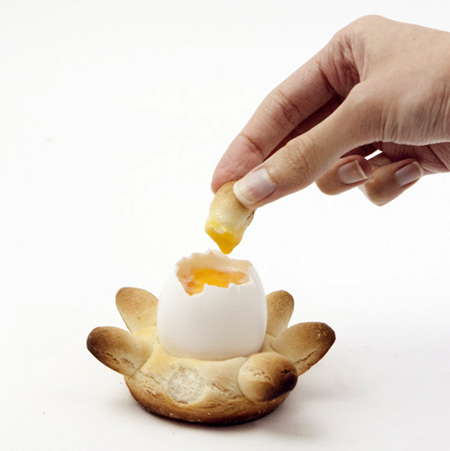London designers Héctor Serrano Studio have sent us images of objects created in a workshop about bread, which they directed for industrial design graduates at the University Cardenal Herrera in Valencia, Spain.
The workshop aimed to generate designs based on social observations.
Top image: Huevón by Reyes Mora. The perfect bread for accompanying a boiled egg. The bread itself has been designed in the shape of an egg-cup, and at the same time you can break pieces off to dip in the egg yolk.
Above: Ñam! by Alberto Silla Morales. This project stems from the past: like many other children, whenever I was sent to buy the bread I always used to break the end off to eat, as it was first thing in the morning and I hadn’t had breakfast yet. When I got home my mother always told me off because I’d made a mess of the baguette by ripping off the end. With this baguette, based on a completely standard one, children can pull off the knob end just like before, but this time without destroying the baguette.
Objects creates by the participants include an egg cup made of bread, a baguette with an extra nobble for smacking on the way home from shopping and boat-shaped pieces of bread for dipping in sauces and oils.
Above: Panchupao by Inma Fenech. A teething ring set and a baby’s dummy. Bread is a staple foodstuff and plays an important role in the traditional European diet. It provides a large amount of carbohydrates, proteins and fibre which are ideal for optimum nutrition. This concept offers babies something healthy to eat while playing and something to bite on when their new teeth are emerging.
Here's some information from Héctor Serrano Studio with captions provided by the designers:
--
Bread as a social element
“Our Daily Bread” explores the more social aspect of this very familiar foodstuff. Over the course of a week, the designers were transformed into bakers – but bakers with a particular interest in the contexts, situations and behaviours related to bread.
The results stem from their observations, with which we can closely identify. A project directed by Héctor Serrano Studio and designed by Industrial Design graduates from the UCH-CEU.
Above: Bread hooks by Juan Soriano Blanco. The baguette that offers a simple and practical mode of transportation. When you go to buy your morning bread and newspaper, this is the best way of keeping your hands free. A new concept of the Spanish saying “con el pan debajo del brazo” (with a loaf under the arm). Then simply hang it from the table.
Above: Pan Nómada by Carles Rodrigo Monzó. The basis of this project is bread and the way it is transported. I have sought to relate it to the objects with which it interacts to resolve the problem. For the bowl, the bread has been used to protect hands from the heat and forms part of the bowl to make it easier to carry. For the plate, I devised a piece of bread that attaches to it. This makes it easier to carry both elements without taking up any additional space. This is extremely useful for catering events where people have to hold both a plate and glass at the same time.
Above and below: Picapan by Ana Navarro Barber. A way of assuaging your hunger before you sit down to eat, without messing up the appearance of the baguette.
Below: Araya by Antonio Benlloch Garrido. Whenever anyone goes on a diet they stop eating bread because they claim it’s very fattening, but this is untrue so long as you eat it in moderation. This project demonstrates the amount of calories in a portion of bread (typically on a 5 cm section) using baked-in marks. Using a simple indented tray for the dough, you can “engrave” the bread.
Below: Meriendame by Reyes Mora. This bread has been designed for children’s mid-morning break: the typical bread and chocolate combination. The idea is a mini-baguette with a hole running through the inside of exactly the same dimensions as the old-fashioned rolled chocolate stick. Nowadays you can only find this chocolate in bakeries, and that’s why it’s a good excuse when buying this roll to buy the chocolate that exclusively fits it at the same time.
Below: Crack-y-Chof by Clara Blasco López. The habit of dipping bread in sauces and “making boats” in salads are the observations that have given rise to this design. Crack-y-Chof is a little boat that reflects this habit which, when separated, lets you dip your bread without getting your fingers dirty. A symbolic nod to our childhood and those “bad” manners!
Below: McQueen by Alberto Silla Morales. This idea also came from a real-life situation: my uncle, Steve McQueen, was at that time holed up in a Nazi concentration camp.
He kept asking me for help and I didn’t know what to do, but now with this idea I’ve got the chance to get him out of there. With this hollowed-out baguette I can fit a file inside so he can escape and get back home to the rest of the family.
Below: Tangram by Marta Guerrero Coloma. A mould that lets you divide a slice of bread into Tangram puzzle pieces so you can create different designs with the pieces of toast. Perfect for kids’ birthday parties.

